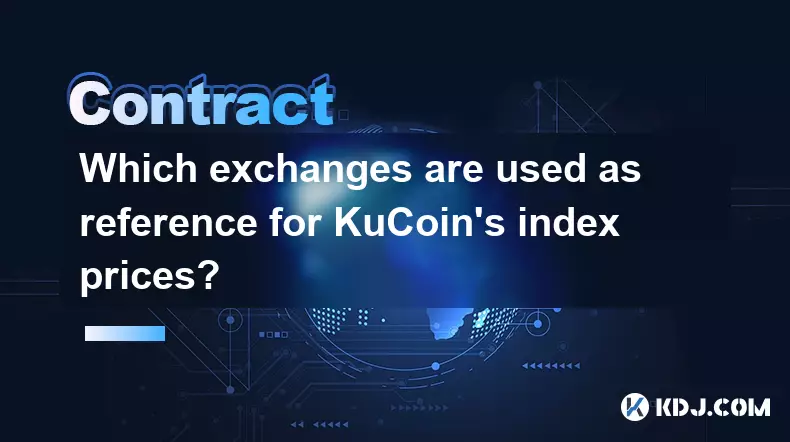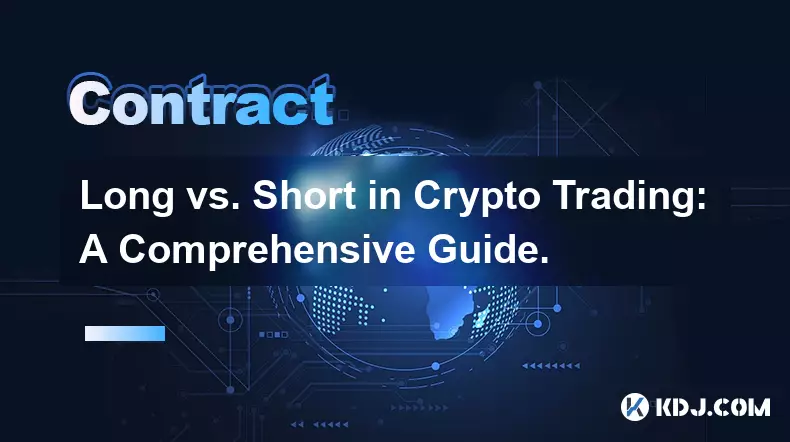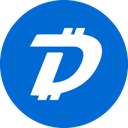-
 bitcoin
bitcoin $107015.826941 USD
-2.18% -
 ethereum
ethereum $3637.352324 USD
-5.18% -
 tether
tether $0.999831 USD
-0.02% -
 xrp
xrp $2.338078 USD
-6.23% -
 bnb
bnb $998.272150 USD
-6.97% -
 solana
solana $167.598257 USD
-10.12% -
 usd-coin
usd-coin $0.999863 USD
0.01% -
 tron
tron $0.282573 USD
-5.09% -
 dogecoin
dogecoin $0.169891 USD
-7.39% -
 cardano
cardano $0.557554 USD
-7.03% -
 hyperliquid
hyperliquid $39.914802 USD
-5.85% -
 chainlink
chainlink $15.414549 USD
-9.97% -
 bitcoin-cash
bitcoin-cash $510.361911 USD
-4.26% -
 ethena-usde
ethena-usde $0.999194 USD
-0.03% -
 stellar
stellar $0.282092 USD
-6.07%
Which exchanges are used as reference for KuCoin's index prices?
KuCoin calculates its index price using a volume-weighted average from top exchanges like Binance, Huobi, OKX, Bitstamp, and Kraken, ensuring accurate, fair, and manipulation-resistant pricing for derivatives and margin trading.
Sep 22, 2025 at 04:01 pm

Understanding KuCoin’s Index Price Mechanism
1. KuCoin determines its index prices by aggregating data from multiple leading cryptocurrency exchanges. This ensures that the pricing reflects a broad market consensus rather than being influenced by anomalies on a single platform. The selection of reference exchanges is based on trading volume, liquidity, security standards, and global reputation.
2. Binance is one of the primary exchanges used in calculating KuCoin's index price. As the largest exchange by trading volume, Binance provides highly reliable and real-time pricing data across numerous trading pairs, making it a critical input for accurate valuation.
3. Huobi Global also contributes to the index calculation. Known for deep order books and consistent market activity, especially in Asian markets, Huobi adds regional diversity and strengthens the robustness of the aggregated price feed.
4. OKX is another key contributor. With advanced matching engines and high-frequency trading support, OKX delivers stable and precise market data that helps maintain fairness in derivative pricing on KuCoin.
5. In addition to these major platforms, KuCoin may include data from other reputable exchanges such as Bitstamp and Kraken, particularly when assessing USD-denominated pairs. These Western-based exchanges offer regulatory compliance and transparency, which enhances data credibility.
Data Aggregation and Weighting Methodology
1. KuCoin applies a volume-weighted average price (VWAP) model when combining data from the reference exchanges. This means exchanges with higher trading volumes have a proportionally greater influence on the final index price, reducing susceptibility to manipulation or low-liquidity distortions.
2. Real-time feeds are monitored continuously, with price updates occurring every few seconds. Sudden spikes or outliers are filtered using statistical algorithms to prevent flash crashes or pump-and-dump schemes from skewing the index.
3. The system excludes exchanges exhibiting abnormal volatility or suspicious trading patterns during specific intervals. This exclusion mechanism ensures only clean, representative data shapes the index value.
4. Time synchronization across all source exchanges is maintained through atomic clock-aligned timestamps, ensuring that price points are evaluated at nearly identical moments for consistency.
5. Transparency reports published periodically by KuCoin detail the exact list of active exchanges and their respective weightings, allowing traders to verify the integrity of the pricing infrastructure.
Impact on Derivatives and Margin Trading
1. The accuracy of the index price directly affects liquidation mechanisms in futures and margin positions. By relying on a multi-exchange benchmark, KuCoin minimizes the risk of unfair liquidations triggered by localized price swings.
2. During periods of high market volatility, such as macroeconomic announcements or black swan events, the diversified index helps stabilize contract valuations and prevents cascading liquidations based on isolated exchange data.
3. Arbitrage opportunities between spot and perpetual contracts are kept within reasonable bounds due to the tight alignment between the index and actual market conditions across top-tier platforms.
4. Traders can view the current index composition and source breakdown directly within the trading interface, enabling informed decisions about entry and exit points based on trusted benchmarks.
5. The use of an externalized index reduces the potential for conflict of interest, as KuCoin does not solely rely on its internal trade data, thereby promoting trust among institutional and retail users alike.
Frequently Asked Questions
How often is the list of reference exchanges updated?KuCoin reviews its reference exchange lineup on a quarterly basis. Adjustments are made if an exchange demonstrates sustained issues with uptime, data accuracy, or regulatory standing. Users are notified in advance of any significant changes.
Can users access raw index data for personal analysis?Yes, KuCoin provides API endpoints that deliver historical and real-time index price data. Developers and quantitative analysts can retrieve timestamped values, component weights, and source exchange contributions for independent verification or strategy development.
What happens if one of the reference exchanges goes offline?If a source exchange becomes unreachable, its data stream is temporarily excluded from the index calculation. The remaining exchanges continue to contribute under adjusted weightings until connectivity is restored, ensuring uninterrupted service without compromising reliability.
Are decentralized exchanges included in the index calculation?Currently, the index relies exclusively on centralized exchanges due to their superior liquidity and faster update frequencies. While DEX data is monitored, it is not yet integrated into the official index because of latency and fragmentation challenges across blockchain networks.
Disclaimer:info@kdj.com
The information provided is not trading advice. kdj.com does not assume any responsibility for any investments made based on the information provided in this article. Cryptocurrencies are highly volatile and it is highly recommended that you invest with caution after thorough research!
If you believe that the content used on this website infringes your copyright, please contact us immediately (info@kdj.com) and we will delete it promptly.
- SMCI Stock: Navigating Q3 Results and Trader Moves in the AI Frenzy
- 2025-11-05 02:40:01
- ZKsync Tokenomics: Utility Shift or Just Another Altcoin Bounce?
- 2025-11-05 00:40:13
- BTC, UK, Treasury Plan: Smarter Web's Bold Bitcoin Bet
- 2025-11-05 01:00:17
- Veterans Day Salute: Army & Air Force Exchange's Coin Giveaway and More!
- 2025-11-05 01:30:12
- Altcoin Investment in 2025: Is BlockchainFX Outperforming Render and Pudgy Penguins?
- 2025-11-05 01:30:12
- Sequans, BTC, and the Selling Stack: A Bitcoin Treasury Strategy Under Scrutiny
- 2025-11-05 02:20:01
Related knowledge

Long vs. Short in Crypto Trading: A Comprehensive Guide.
Nov 04,2025 at 07:39pm
Understanding Long and Short Positions in Cryptocurrency Markets1. In crypto trading, taking a long position means buying a cryptocurrency with the ex...

The 2025 Guide to Profitable Crypto Futures and Derivatives Trading.
Nov 01,2025 at 07:39pm
Understanding Crypto Futures and Derivatives in 20251. Crypto futures are financial contracts obligating the buyer to purchase, or the seller to sell,...

Navigating a Bear Market: Shorting Strategies for Crypto Futures.
Nov 03,2025 at 07:18pm
Understanding Bear Market Dynamics in Crypto1. A bear market in the cryptocurrency space is characterized by prolonged price declines, often driven by...

What is Open Interest? A Key Metric for Futures Traders.
Nov 03,2025 at 11:18pm
Understanding Open Interest in Cryptocurrency Futures1. Open interest refers to the total number of active futures contracts that have not been settle...

How to Trade Crypto Futures on Bybit: A Complete Walkthrough.
Nov 04,2025 at 10:50pm
Setting Up Your Bybit Account for Futures Trading1. Visit the official Bybit website and click on the 'Sign Up' button to create a new account. Provid...

Identifying Support and Resistance Levels for Crypto Contract Trading.
Nov 04,2025 at 06:15pm
Understanding Support and Resistance in Crypto Markets1. Support and resistance levels are foundational concepts in technical analysis, especially wit...

Long vs. Short in Crypto Trading: A Comprehensive Guide.
Nov 04,2025 at 07:39pm
Understanding Long and Short Positions in Cryptocurrency Markets1. In crypto trading, taking a long position means buying a cryptocurrency with the ex...

The 2025 Guide to Profitable Crypto Futures and Derivatives Trading.
Nov 01,2025 at 07:39pm
Understanding Crypto Futures and Derivatives in 20251. Crypto futures are financial contracts obligating the buyer to purchase, or the seller to sell,...

Navigating a Bear Market: Shorting Strategies for Crypto Futures.
Nov 03,2025 at 07:18pm
Understanding Bear Market Dynamics in Crypto1. A bear market in the cryptocurrency space is characterized by prolonged price declines, often driven by...

What is Open Interest? A Key Metric for Futures Traders.
Nov 03,2025 at 11:18pm
Understanding Open Interest in Cryptocurrency Futures1. Open interest refers to the total number of active futures contracts that have not been settle...

How to Trade Crypto Futures on Bybit: A Complete Walkthrough.
Nov 04,2025 at 10:50pm
Setting Up Your Bybit Account for Futures Trading1. Visit the official Bybit website and click on the 'Sign Up' button to create a new account. Provid...

Identifying Support and Resistance Levels for Crypto Contract Trading.
Nov 04,2025 at 06:15pm
Understanding Support and Resistance in Crypto Markets1. Support and resistance levels are foundational concepts in technical analysis, especially wit...
See all articles










































































